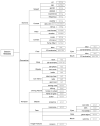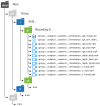Challenges of Large-Scale Multi-Camera Datasets for Driver Monitoring Systems
- PMID: 35408169
- PMCID: PMC9003494
- DOI: 10.3390/s22072554
Challenges of Large-Scale Multi-Camera Datasets for Driver Monitoring Systems
Abstract
Tremendous advances in advanced driver assistance systems (ADAS) have been possible thanks to the emergence of deep neural networks (DNN) and Big Data (BD) technologies. Huge volumes of data can be managed and consumed as training material to create DNN models which feed functions such as lane keeping systems (LKS), automated emergency braking (AEB), lane change assistance (LCA), etc. In the ADAS/AD domain, these advances are only possible thanks to the creation and publication of large and complex datasets, which can be used by the scientific community to benchmark and leverage research and development activities. In particular, multi-modal datasets have the potential to feed DNN that fuse information from different sensors or input modalities, producing optimised models that exploit modality redundancy, correlation, complementariness and association. Creating such datasets pose a scientific and engineering challenge. The BD dimensions to cover are volume (large datasets), variety (wide range of scenarios and context), veracity (data labels are verified), visualization (data can be interpreted) and value (data is useful). In this paper, we explore the requirements and technical approach to build a multi-sensor, multi-modal dataset for video-based applications in the ADAS/AD domain. The Driver Monitoring Dataset (DMD) was created and partially released to foster research and development on driver monitoring systems (DMS), as it is a particular sub-case which receives less attention than exterior perception. Details on the preparation, construction, post-processing, labelling and publication of the dataset are presented in this paper, along with the announcement of a subsequent release of DMD material publicly available for the community.
Keywords: ADAS; automotive; datasets; driver monitoring; multi-camera.
Conflict of interest statement
The authors declare no conflict of interest.
Figures










References
-
- Wang W., Liu C., Zhao D. How much data are enough? A statistical approach with case study on longitudinal driving behavior. IEEE Trans. Intell. Veh. 2017;2:85–98. doi: 10.1109/TIV.2017.2720459. - DOI
-
- Terzi R., Sagiroglu S., Demirezen M.U. Big Data Perspective for Driver/Driving Behavior. IEEE Intell. Transp. Syst. Mag. 2020;12:20–35. doi: 10.1109/MITS.2018.2879220. - DOI
-
- Saab . Saab Driver Attention Warning System. The Saab Network; Brussels, Belgium: 2007.
-
- Toyota Motor Corporation . Toyota Enhances Pre-Crash Safety System with Eye Monitor. Toyota Motor Corporation; Aichi, Japan: 2008.
-
- Volvo Car Group . Volvo Cars Conducts Research into Driver Sensors in Order to Create Cars That Get to Know Their Drivers. Volvo Car Group; Gothenburg, Sweden: 2014.
MeSH terms
Grants and funding
LinkOut - more resources
Full Text Sources
Research Materials

